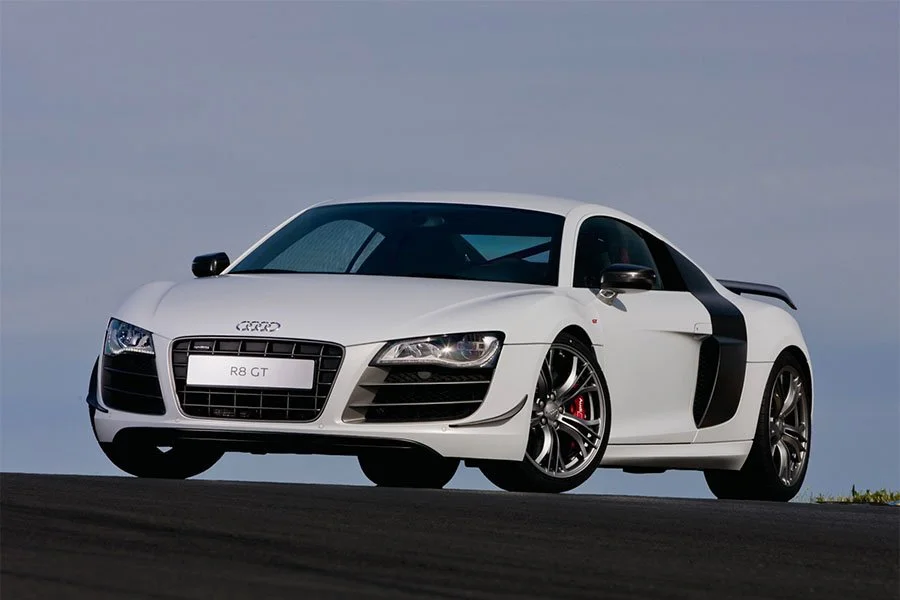Guide: Audi Avus - a Historical & Technical Appraisal
/BACKGROUND
Thanks principally to the iconic Quattro, Audi began to transform their image from builder of pedestrian utility vehicles to prestige brand. As the 1990s dawned, machinery that bore the famous four-ringed logo was increasingly seen as a genuine BMW or Mercedes-Benz alternative.
By the end of that decade, Audi had arguably become the most fashionable of all German car manufacturers.
In addition to handsome and well engineered production models, Audi chose to demonstrate their future technologies with a series of aspirational concepts starting with the Quattro Spyder displayed at the Frankfurt Motor Show in October 1991.
The pretty mid V6-engined two-seater was extremely well received and looked almost production-ready.
Less than three weeks after the Frankfurt Show had opened, Audi stunned the motoring world with one of the most exciting automotive concepts in years: the W12-powered Avus.
Unveiled at the Tokyo Motor Show during the last week of October, this latest design study was named after the Automobil-Verkehrs-und Ubungsstrasse (AVUS) opened in Berlin during 1921.
In addition to having been the oldest controlled-access highway in Europe, AVUS was also used as a motor racing circuit. It comprised two straights each of approximately six miles with a hairpin bend at either end.
From 1937 the northern hairpin was redeveloped to incorporate steep 43° banking.
Audi’s history at AVUS began in 1934 when the new Auto Union Type As faced off against the Mercedes-Benz W25. On that occasion, it was a Scuderia Ferrari Alfa Romeo P3 that won but, over the next few years, the Silver Arrows, funded by Adolf Hitler’s Nazi party, went on to dominate.
Although Auto Union never won a Grand Prix at AVUS, in 1937 the Berlin circuit was the location for a Type C to set the fastest motor racing lap in history.
As that year’s event did not count towards the European Championship, streamlined cars similar to those used for record attempts were permitted to attend. During qualifying for the second heat, Luigi Fagioli’s Auto Union Type C Stromlinie lapped at an average speed of 176.7mph, a record that stood for over 20 years.
Fagioli’s famous steed was clearly the inspiration for Audi’s 1991 Avus concept. Similarly equipped with a polished aluminium body, it previewed a forthcoming mid-mounted W12 engine that was expected to produce over 500bhp.
CHASSIS
Aluminium construction was also on show to include the lightweight tubular spaceframe. This had a long 2800mm wheelbase (necessary to accommodate the enormous engine) but weighed just 52kg.
A state-of-the-art four-wheel drive system incorporated three lockable differentials.
Four-wheel steering was also installed.
Suspension was via double wishbones with coil sprung gas-filled dampers and anti-roll bars at either end.
Anti-lock brakes and ventilated discs were fitted along with enormous 20 x 8-inch wheels that made up practically half the car’s height.
ENGINE / TRANSMISSION
Although the Avus was only fitted with a dummy engine created from plastic and wood, Audi did have a W12 power unit in the early stages of development. It used three rows of four cylinders and would be mounted longitudinally.
Dual overhead camshafts were employed along with five valve cylinder heads. Displacement was 5998cc thanks to a bore and stroke of 84mm and 90.2mm respectively.
Output was predicted to be 509bhp at 5800rpm and 398lb-ft at 4000rpm.
The Avus used a six-speed manual gearbox mounted between the front wheels to optimise weight distribution.
BODYWORK
Despite this advanced technical specification, it was the Avus bodywork that really stole the headlines.
Long, wide and impossibly low, its hand-beaten aluminium panels were just 1.5mm thick and the entire shell weighed less than 100kg.
Like the Auto Union Type C Stromlinie, the Avus had a forward-mounted cabin and long rear deck. The blisters above each wheel also evoked Fagioli’s 1937 record breaker.
Underbody aerodynamics and a massive rear diffuser meant there was no need for large spoilers.
Scissor doors came with rear view mirrors mounted high up on the A-pillars.
Discrete intakes were mounted down each flank but the engine was principally fed by an enormous NACA duct located on the otherwise glass roof. Probably the biggest NACA duct ever used on an automobile, it was finished in polished aluminium like the majority of the Avus body panels.
INTERIOR
Once across the wide sills, occupants were treated to carbonfibre racing seats trimmed in red leather. The rest of the upholstery was mostly light grey alcantara suede.
All the instrumentation was housed in a curvaceous binnacle directly behind the steering wheel. Analogue gauges were mixed with digital readouts and there was also a state-of-the-art trip computer.
Light was plentiful thanks to the large windows and glass roof.
WEIGHT / PERFORMANCE
For an anticipated production version, Audi quoted figures of 1250kg, 211mph and 0-62mph in 2.9 seconds.
SUBSEQUENT HISTORY
Unlike the Quattro Spyder, which had been unveiled just a few weeks before, the Avus was never seriously considered for production despite a small number of customers reputedly offering to pay around $10m for such a car.
However, the W12 engine did later find its way into the 2001 Audi A8.
By this time, the Volkswagen Audi Group (VAG) had purchased Bugatti and, in 2005, production began of a spiritual successor to the Avus: the Bugatti 16.4 Veyron.
Text copyright: Supercar Nostalgia
Photo copyright: Audi - https://www.Audi.com


































